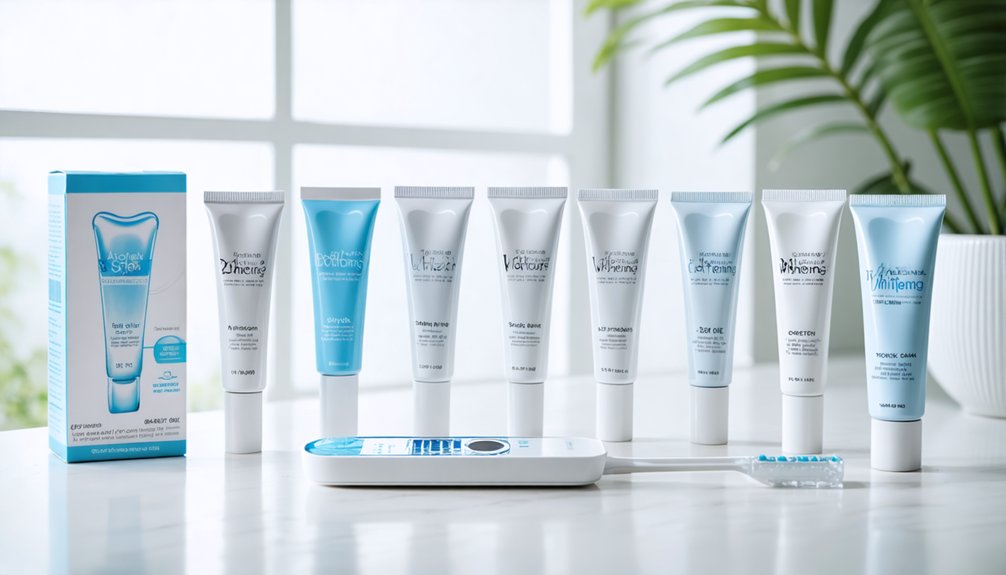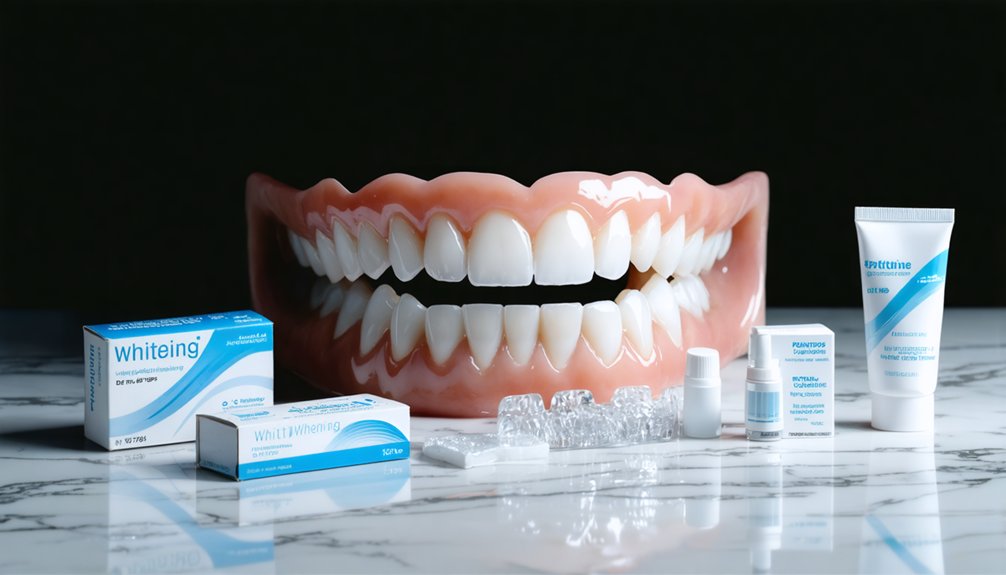You’ll find Crest 3D Whitestrips Professional Express consistently ranks as the most effective whitening solution, delivering up to 18 shade improvements within two weeks. These strips use 6-14% hydrogen peroxide to penetrate your enamel and break down stain molecules through oxidation. For sensitive teeth, consider gentler options like Moon’s Dissolving Strips or products containing carbamide peroxide. Understanding the active ingredients and proper application techniques can greatly impact your whitening results.
Key Takeaways
- Crest 3D Whitestrips leads the market with proven results of up to 18 shades whiter in two weeks.
- Effective whitening strips contain 6-14% hydrogen peroxide as the primary active ingredient for stain removal.
- Professional-grade strips with LED technology, like Auraglow and Snow, provide enhanced whitening results through light activation.
- Consistent twice-daily application for 30 minutes over 14 days delivers optimal whitening results.
- Strips containing PAP offer gentler whitening for sensitive teeth but may be less effective on severe stains.
Top-Rated Whitening Strip Brands and Their Results
Five leading whitening strip brands have emerged as top performers in the quest for brighter smiles.
Crest 3D Whitestrips deliver visible changes in just one hour, setting the standard for fast results. These strips can whiten teeth by up to 18 shades in two weeks.
Zimba Whitening Strips brighten teeth by an average of 2.7 shades within two weeks, offering an enhanced user experience through pleasant flavors. The strips come in six unique flavors to make the whitening process more enjoyable.
Moon’s Dissolving Whitening Strips provide a gentle solution that dissolves in 15 minutes, making them ideal for those with sensitivity concerns.
Auraglow incorporates LED technology to boost whitening power, though you’ll need to maintain consistent application frequency for best results.
Laughland Whitening Kit rounds out the top options with its personalized formulas designed for both comfort and efficiency, ensuring you’ll achieve the bright smile you’re seeking through regular use.
Understanding Active Ingredients and How They Work
Three primary active ingredients power modern whitening strips, each operating through distinct chemical mechanisms to brighten your smile.
Hydrogen peroxide, the most common active ingredient, breaks down into water and oxygen, penetrating your enamel to dissolve stain molecules. You’ll find it in concentrations of 6-14% in over-the-counter strips.
For sensitive teeth, carbamide peroxide offers a gentler approach, decomposing slowly to release hydrogen peroxide and urea.
The newest innovation, PAP (phthalimidoperoxycaproic acid), provides peroxide-free whitening by oxidizing stains without significant enamel damage. Daily treatments over 14 consecutive days are typically needed to achieve optimal whitening results.
These whitening mechanisms work through oxidation, breaking down pigmented molecules into less visible forms. The tooth’s chicken wire structure naturally traps stains, making effective whitening agents crucial for deep cleaning.
While natural components like Dead Sea salt and lemon peel oil can assist with surface stains, they’re primarily effective for maintenance rather than deep whitening.
Application Methods for Maximum Effectiveness
To achieve ideal whitening results with dental strips, proper application techniques must be followed meticulously.
Start by thoroughly cleaning your teeth, then gently dry them to guarantee maximum strip adhesion. Apply strips carefully to cover all visible tooth surfaces, avoiding overlap and ensuring they conform closely to tooth contours. The recommended application duration is typically 30 minutes, twice daily for 14 days. Whitening strips with peroxide-based gel effectively remove surface stains from teeth.
After removing the strips, rinse your mouth gently and brush your teeth with care. You’ll want to avoid staining substances for several hours following treatment. Results should be noticeable within a few days of consistent use.
For best results, maintain consistent strip placement at the same times each day, preferably in the evening to minimize exposure to food and drinks. Monitor for any sensitivity and discontinue use if persistent irritation occurs.
Managing Sensitivity and Safety While Whitening
While teeth whitening can effectively brighten your smile, managing sensitivity during treatment requires careful attention to several key factors. Most sensitivity occurs due to nerve inflammation from peroxide exposure.
For ideal sensitivity management, choose strips with lower peroxide concentrations (5.3-6.5%) and limit application times. You’ll want to use desensitizing toothpaste containing potassium nitrate before and during treatment to calm nerve sensitivity. Temporary discomfort is a normal side effect that typically subsides after treatment.
Essential safety precautions include avoiding hot and cold beverages, acidic foods, and excessive treatment times. If you have dental restorations or pre-existing conditions like gum recession, consult your dentist first.
Professional supervision can help tailor the treatment to your needs. Consider using fluoride treatments to strengthen enamel, and don’t overfill whitening trays, as excess gel can irritate gums and increase sensitivity.
Comparing Cost and Value Across Leading Products

Selecting the most cost-effective whitening strips requires careful evaluation of price points, treatment duration, and included features across leading brands.
When comparing products, you’ll find Crest 3D Whitestrips Professional Express offers solid value at $60, delivering 2.6 shades of whitening in 19 days with an included LED device.
While Auraglow presents a budget-friendly option, it requires longer treatment periods. For faster results, Crest Radiant Express claims up to 18 shades in two weeks but costs up to $80.
Budget-conscious shoppers can opt for Auraglow’s slower whitening process, while those seeking rapid results may prefer Crest Radiant Express’s premium solution.
Premium systems like Snow and GLO command higher prices but include advanced LED technology to accelerate whitening. At-home strips and kits containing hydrogen peroxide provide professional-grade results at a fraction of in-office treatment costs.
HiSmile’s gentler PAP formula costs less but may not address severe staining effectively.
Consider your specific needs and sensitivity concerns when weighing cost effectiveness against features and treatment duration.
Frequently Asked Questions
Can I Drink Coffee or Wine While Using Whitening Strips?
You shouldn’t drink coffee or wine during whitening treatment, as their staining effects will counteract your results. Wait 24-48 hours after completing treatment before consuming these beverages to maintain whitening benefits.
How Long Should I Wait After Brushing to Apply Whitening Strips?
You’ll need to wait 30 minutes after brushing before whitening strip application. Rinse thoroughly after brushing to remove toothpaste residue that could interfere with the strips’ effectiveness.
Will Whitening Strips Work on Dental Crowns or Veneers?
You might wish they did, but whitening strips won’t affect your dental crowns or veneers. These restorations’ non-porous materials resist whitening effectiveness, maintaining their original shade regardless of treatment.
Can Teenagers Safely Use Teeth Whitening Strips?
You shouldn’t use whitening strips before age 14-16 due to safety concerns with developing teeth. Wait until all permanent teeth emerge and consult your dentist to prevent enamel damage.
Should I Whiten My Bottom Teeth if They’re Less Visible?
You should whiten your bottom teeth despite lower visibility, as whitening effectiveness is similar for both arches. This guarantees uniform color and prevents noticeable mismatches when you’re speaking or laughing widely.
References
- https://nhdentistrybeverlyhills.com/press/6-of-the-best-teeth-whitening-kits-in-the-drugstore/
- https://www.tribecasmiles.com/best-teeth-whitening-strips-fast-results-2025
- https://www.goodhousekeeping.com/health-products/g28723133/best-at-home-teeth-whitening-products/
- https://g-p-dental.com/best-teeth-whitening-kits-in-2025-safe-option/
- https://pmc.ncbi.nlm.nih.gov/articles/PMC4058574/
- https://icybeardental.com/blogs/blog/teeth-whitening-strips-vs-other-whitening-methods-which-is-best
- https://www.theunorthodoc.com/main-blog/whitening-strips-a-comprehensive-review
- https://www.healthline.com/health/do-whitening-strips-work
- https://www.carolinasdentist.com/teeth-whitening-strips/
- https://www.medicalnewstoday.com/articles/whitening-strips



